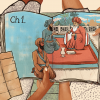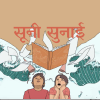The Diamond Library premises stand proudly on the busy thoroughfare that is the present day Chitpur Road (Rabindra Sarani), an elegant counterpoint to the glitzy jatra companies (or operas, as they are called) that dot the area. It is impossible to miss the signboard that proudly announces the name of the publishing house and the date of its establishment, hand-painted in a simple cursive reminiscent of the cover pages of titles and posters from yesteryears, before the advent of digital print. Diamond Library, with its unique collection of jatra texts among other things, and its rich legacy, is one of the last remaining bookstores in the once-thriving Chitpur-Garanhata area. In this interview, we speak with Mr Baidyanath Seal, who, along with his brother Ganeshchandra Seal, runs the Diamond Library.
*
Swati Moitra: My first question is about the early days of your establishment. I know there is a signboard outside that mentions the date of establishment [of the Diamond Library], but I would like to hear it from you nonetheless.
Baidyanath Seal: [Diamond Library was established] in 1284 [1877], as per the Bengali calendar.
S.M.: Who established the business?
B.S.: It was established by my grandfather, Naderchand Seal.
S.M.: Has your establishment been associated with the jatra world from that time itself? What sort of books did you publish?
B.S.: All sorts of books were published at the time. Pachali, Ramayan, Mahabharat, all sorts of things.
S.M.: True, books like this were quite popular at the time. I have learned in the course of my research that women in particular used to read these books a lot.
B.S.: We also published novels.
S.M.: What sort of novels?
B.S.: They were all novels from that period.
S.M.: Could you offer some examples? Of course, only if you have any in mind.
B.S.: They were all writers from that period. All very ordinary writers, writing about ordinary matters. That’s what sold.
S.M.: Of course. In the course of my research I found that women of the household in particular really enjoyed these books.
B.S.: [We had] books like Bishadrishti, Udashini Rajkanyar Guptakatha, Senapatir Guptarahashya.
S.M.: I can’t say I have heard these names. But it does sound like these were thrilling historical narratives.
B.S.: You can’t have heard these names.
S.M.: It’s true that I haven’t heard these names, but I would definitely like to hear more. Everyone has heard of Durgesh Nandini, but what about the humble books that ordinary women read? Everybody read Bankimchandra [Chatterjee’s] works, of course, but they read these books as well.
B.S.: There are many more titles. I do not remember their names right now.
S.M.: How were these books priced?
B.S.: How expensive could they be in those days? One rupee, four annas… back then, we had annas and paisas. The books were priced accordingly in terms of rupees, paisas, annas.
S.M.: Your books are moderately priced even now. I can imagine how cheap the prices must have been at the time.
B.S.: Of course. The value of money was different then. Because things were so cheap, books were also cheaply priced.
S.M.: Has your bookstore been here from that time itself? Or was it located elsewhere?
B.S.: Earlier it was somewhere across the road. There was a banyan tree in these parts in those days.
S.M.: Is that where the name Battala comes from?
B.S.: That’s what I was going to say.
S.M.: Have you seen the banyan tree?
B.S.: No, my brother or I have not seen the banyan tree. But we have heard that people used to sit under the banyan tree with books, like they do in fairs even now. Cheaply priced—two annas, four annas, one anna.
S.M.: How did the books reach people?
B.S.: People used to come here to buy books. The postal services were not equipped to handle the transport of books like this in the early days.
S.M.: I believe bookstores didn’t exist in the early days of Battala either. I have read about hawkers who distributed books across the city.
B.S.: Yes, there were hawkers. And besides, there were a lot of other books published at the time, books that are known as ‘Battalar boi’ (Battala books). Some people say that all Battala books are obscene books.
S.M.: That is not true at all. For instance, your store alone sells religious books of all sorts. Battala too sold different sorts of books, from obscene books to religious books.
B.S.: The variety of books that we sold then is no longer published, because the demand for them no longer exists. But books like Mahabharat and Ramayan are still published.
S.M.: If I may come back to the present day and ask a few questions… You said that your grandfather, Mr Naderchand Seal, started this business of yours. But before that, what was your family’s occupation?
B.S.: I can’t say. This was before our time, as you know, and we never asked. We have grown up watching this book business… we have always known that our family sells books. So you can say that this is our ancestral business.
S.M.: Did you establish this particular bookstore [at Chitpur], or was it established before, during your father’s time?
B.S.: After my grandfather, Mr Naderchand Seal, the business was taken over by my uncle, Mr Kanailal Seal, and my father, Surjakanta Seal. After their passing, the two of us took over the business. Another brother of ours was also involved in the business, but he has passed away as well. So it is just us, Baidyanath Seal and my brother, Ganeshchandra Seal. We run this business now. But considering the state of the jatra industry now, I cannot say how long we will be able to continue running this business. The art of jatra itself is increasingly an endangered one.
S.M.: That is indeed true. Jatra has changed a lot. I won’t say it is an extinct art form, but it certainly has changed in nature.
B.S.: It has changed a lot. Our government is trying to help a number of endangered art forms these days.
S.M.: Yes, that’s true.
B.S.: But where is the attempt to re-energize the world of jatra? Sometimes they hold jatra events here and there for a month or so. Sometimes they hold festivals and call them jatra festivals, like the one that’s held at Bagbazaar.
S.M.: I’ve watched a performance at the Phanibhushan [Bidyabinod] Mancha as well.
B.S.: Yes, but it’s only for those few days that anyone cares about jatra.
S.M.: True, true. It’s very poorly advertised as well. If I want to know what’s going on at the festival, I will have to physically come here to figure out, I can’t check it online. But nowadays we are used to Googling for every bit of information.
B.S.: Everything has changed. And besides, jatra was always more popular in the rural areas, for all that it is performed in the city nowadays as well.
S.M.: I grew up in a small town as well. We had traveling jatra troupes visiting the town at the time.
B.S.: Some of it is performed in theaters as well these days. But the problem is with the fact that the popularity of jatra has gone down in the most important places [in rural areas]. I don’t know why this has happened. It’s as though people no longer want to perform jatra. I don’t know why.
S.M.: Could cinema be a reason?
B.S.: I would say it’s television that has significantly contributed to the downfall of jatra.
S.M.: That is true. If people can be entertained within the four walls of their home, then why would they pay to watch a jatra elsewhere? They will simply not pay for a jatra party’s tour.
B.S.: Earlier, people used to watch jatra all night and go home in the early hours of the morning. All that no longer happens. There are a lot of television channels. They show many different things on television.
S.M.: Nowadays, you can watch the television on your phone. My students don’t watch television anymore—they just watch whatever they want on their phones. So you’re right, things have changed.
B.S.: Jatra lovers often tell us, 'Why are so few jatras performed these days?' They tell us that the women of their households earlier used to go for jatra performances. Now they watch TV. They cook in the course of the day and sit in front of the television before 6:00 [p.m].
S.M.: We also watch saas-bahu soaps at home.
B.S.: This is true for rural areas as well. Nowadays women don’t make rotis at home anymore. You have to go and buy roti from the market. When the husband comes back from the office, she tells him how many to buy.
S.M.: I have another question. The jatra texts that you produce, are these all productions that are performed by Chitpur-based companies?
B.S.: No, we don’t publish everything that is performed here. The palas performed here, they are centered around one or two characters alone, the stars. Now the palas we publish, they have 10, 15, even 20 characters, but the palas performed here will have eight to ten characters at best. We need to cover production cost as well, so we need to produce a certain volume of books.
The operas work in a certain way, featuring a star or two. Maybe there are a few more characters surrounding the hero and the heroine, that’s all they need to run the pala. But the texts we print are for amateur jatra clubs in rural areas. Now there you will need at least 10 to 12 characters, maybe more. A rural club can’t just perform something that has only two main characters. Everyone needs a part. It runs on donations, which means that people who are spending money will also want to participate and perform.
S.M.: Amateur theatre runs in a similar manner sometimes.
B.S.: It’s a form of recreation. Jatra also seeks to educate people.
S.M.: Hence the social themes.
B.S.: Not just social. Historical, mythological. Earlier, these themes were more popular. People were not as educated, they read less. So jatra became a medium of popular education. They could learn about Ram and Ravan, about good and bad, about who did what.
S.M.: I have also read that once upon a time, most of the performances were based on mythological narratives.
B.S.: Yes, a long time ago. The social palas became popular in our lifetime. The historical palas are older. At first jatra was just the mythological palas, then came the historicals. There were palas about wars and revolutions, on themes like Emperor Akbar...
S.M.: I remember a pala called Aurangzeb from my childhood.
B.S.: Yes, then you had Shah Jahan. Bappaditya. So many.
S.M.: I have also noticed that you keep religious texts for sale.
B.S.: Our publishing house has a number of religious texts, which we keep here. Our local buyers buy copies of Ramayan, Mahabharat, Gita, and so on, so we keep those as well.
S.M.: These books are always in demand.
B.S.: This is a part of our business.
S.M.: In our country, people’s lives are intimately entwined with religion.
B.S.: You know that saying about decorating your flower vase with all sorts of flowers… Here, we keep things that are in demand throughout the year so that our customers can also come to us throughout the year. People who sell textbooks for school children sell them for a few months. Medical and engineering books do well in the market as well. But we keep books that sell throughout the year, which is why we have customers throughout the year.
S.M.: If I may ask a slightly different question, do you have a printing press of your own?
B.S.: We did, once upon a time.
S.M.: Did it run on letterpress?
B.S.: Yes, but no one uses letterpress machines for printing anymore, all of it is offset printing now. Books published earlier were a little different. The paper was different, the ink was different. Some of the older books are more resilient than the books we publish now.
(With this, the interview proceeded to some displays of their older material, a lot of which is no longer on sale and for display only. The interviewer eventually thanked the proprietors for their time and concluded the interview.)











